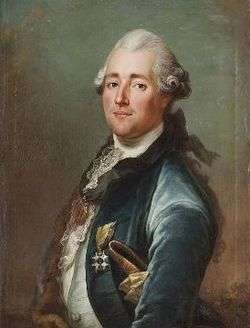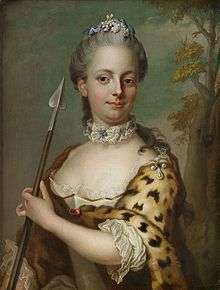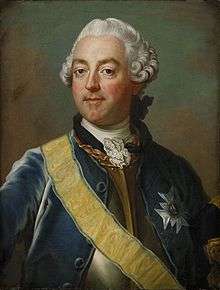Jakob Björck
Jakob Björck[1] (1727 or 1728 - February 20th 1793 in Stockholm) was a Swedish portrait painter and copyist.
Jakob Björck | |
|---|---|
| Died | February 1793 (aged 65–66) |
| Nationality | Swedish |
| Occupation | portrait painter and copyist |
Biography
In the early stages of his career, Björck is reported to have been a pupil of Johan Henrik Scheffel,[2] however this is uncertain. He worked in the studio of pastel painter Gustav Lundberg between 1750 and 1774. In 1774, Björck married Cicilia Gren (1723 or 1724 - 1811).
In Lundberg's studio 1750-1774
Oil copies of Lundberg's pastels are usually attributed to Björck, despite several other assistants being employed in the studio at the time: Per Cogell (later a city painter in Lyon), Adolf Hall, Jonas Forsslund and a pastel painter named Pettersson. In addition, Lundberg had so many orders at times that he delegated the copy orders to other artists - Johan Henrik Scheffel and Fredrik Brander. Moreover, it seems that Ulrika Pasch, Olof Arenius, the court miniaturist John George Henrichsen as well as Niklas Lafrensen the Elder all had access to Lundberg's originals.[3]
It was well known at the time that pastel paintings are sensitive to light, moisture and touch, wherefore it was common to order oil copies from the outset. An example of this can be seen in the Swedish Count Carl Gustaf Tessin's diary[4], into which he had copied the following receipt from Lundberg:
Un portrait original en pastel de Son Excellence Monseigneur le Comte de Tessin avec cadre et glace Dlr cuivre 1.300
Un dito de Madame La Comtesse de Tessin 1.300
Deux copies en huile du Portrait de son Excellence à 200 d 400
Deux cadres pour les dites copies 300
Translated from French:
One original portrait in pastel of His Excellence my Lord the Count of Tessin with frame and glass copper : 1,300 talers
One ditto of Madame the Countess of Tessin : 1,300
Two copies in oil of the Portrait of His Excellence, at 200 talers each : 400
Two frames for the aforesaid copies : 300
The portraits being referred to are one of Tessin in a riksrådsdräkt (a formal attire worn by the Privy Council of Sweden) and one of his wife Ulrika Lovisa in a yellow dress and a black lace mantilla. Of the former there are ten copies registered in Svenska Porträttarkivet, all of which are attributed to Björck; same goes for four copies of the latter,[5] which had apparently been ordered at a different time.
Björck also made pastel copies, but there are no known works which could with certainty be attributed to him.[6] Upon the end of his employment at the studio, Lundberg thanked him with a small cabinet of pastel sticks and a copper plate collection as recognition for "24 years of faithful service".
On his own since 1774
Björck had since 1774 an own production, where he mainly copied the works of others, such as one of Jean-Baptiste Oudrys door lintels in the Royal Palace, Hunting dog with two grouse, which he signed Iacob Björck px on stent . He was able to paint King Gustav III and the Life Guards uniform with revolutionaries armband[7] and partly in Swedish costume[8], both in the magnificent royal frames. In general, however, assumes that he copied from the now lost or destroyed works by Lundberg. Björck had the title HofCopist, probably Lundberg's instigation in order to avoid problems with painting the office.[9]
His own style is rough compared to Lundberg's easy elegance. This is evident from the portraits of King Gustav III and Adolf Ludvig Stierneld below in the gallery. In time, his production purely handcrafted and copies after the many stereotypical portraits of Lundberg's last days are consistently dry and lifeless.[10] The portraits of Gustavus Gyllenborg, his wife Petronella Hultman and the copy of Lundberg's self-portraits in the below gallery can be seen as an example this. Björck copies of Lundberg's portraits during the 2000s the first decade sold for anything from 20,000 to 180,000 SEK depending not least on the frame. Gold plated and richly carved frames are often more appreciated than their content. Child and damporträtt generally valued higher than men's portraits.[11]
Gallery
 Portrait of Jacob Johan Anckarström the Elder[12]
Portrait of Jacob Johan Anckarström the Elder[12] Portrait of countess Charlotte Du Rietz af Hedensberg, copy after a pastel by Gustaf Lundberg.[13]
Portrait of countess Charlotte Du Rietz af Hedensberg, copy after a pastel by Gustaf Lundberg.[13] Portrait of count Anders Rudolf Du Rietz af Hedensberg (1720-1792), copy after a pastel by Gustaf Lundberg.[14]
Portrait of count Anders Rudolf Du Rietz af Hedensberg (1720-1792), copy after a pastel by Gustaf Lundberg.[14] Portrait of Adolf Ludvig Stierneld
Portrait of Adolf Ludvig Stierneld
Sources
- "Jakob Björck". Nordisk familjebok (1st ed.). 1878 – via Project Runeberg.
- Herman Hofberg (1906). "Jakob Björck". Svenskt Biografiskt handlexikon (2nd ed.) – via Project Runeberg.
- Oscar Levertin; Gustaf Lundberg - en studie (Ljus, Stockholm 1902)
- Merit Laine and Carolina Brown; Gustaf Lundberg 1695-1786 (Nationalmuseum 2006)
- Boo von Malmborg; Svensk Porträttkonst (Allhems Förlag och Nationalmuseum 1978)
- Carl Gustaf Tessin; Dagbok 1760 och 1761 (Handskrift, Kungl. Biblioteket)
- Index över svenska porträtt; Sixten Strömbom (Nationalmuseum 1939)
- Svenskt Biografiskt Lexikon (SBL) 1924, article by Gunnar Mascoll Silfverstolpe
Notes
- Alternate spelling "Björk" appears in some sources.
- Svenskt Biografiskt Lexikon
- Laine/Brown p. 203
- Carl Gustaf Tessin: Åkerödagboken december 1761
- Index över svenska porträtt
- Laine and Brown p. 219
- Sold for 250.000 SEK at Stockholms Auktionsverk in the Spring of 2010
- Sold for 72.000 SEK at Bukowskis in 1990
- Laine and Brown p. 201
- Svensk Biografiskt Lexikon
- http://auktionsverket.se/search/?q=Jakob+Bj%C3%B6rck
- Sold in a magnificent sculpted frame for 180.000 kr at Bukowskis in May 2007
- Sold for 60.000 SEK at Stockholms Auktionsverk in the Spring of 2010
- Sold för 57.000 SEK at Stockholms Auktionsverk in June 2010